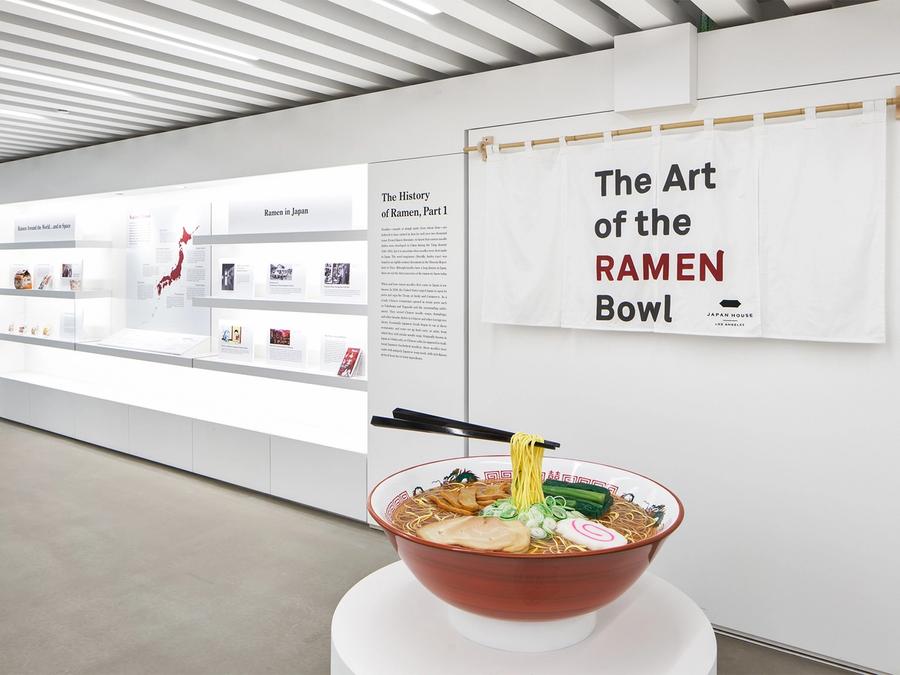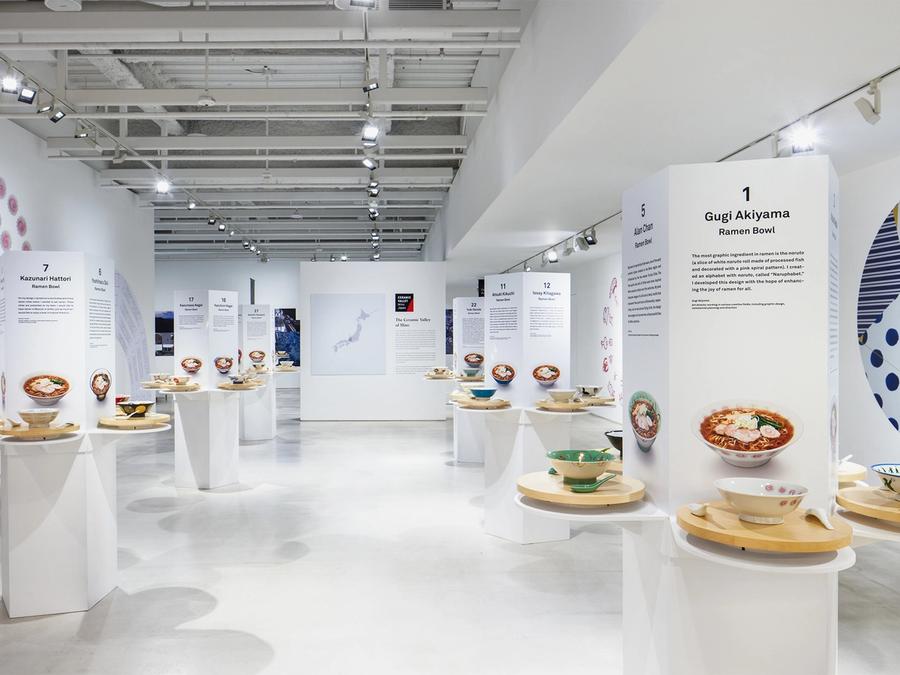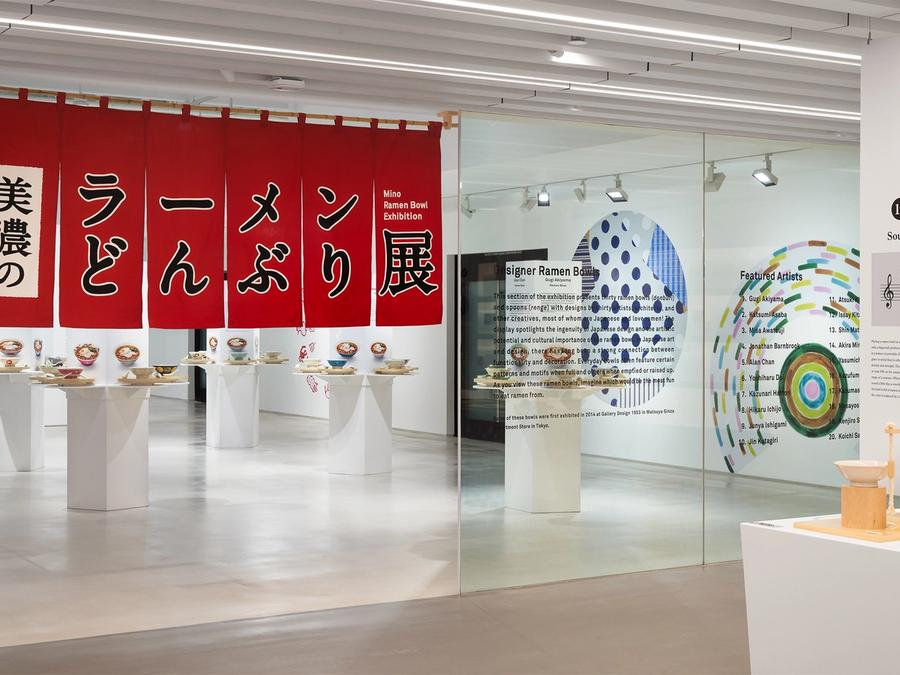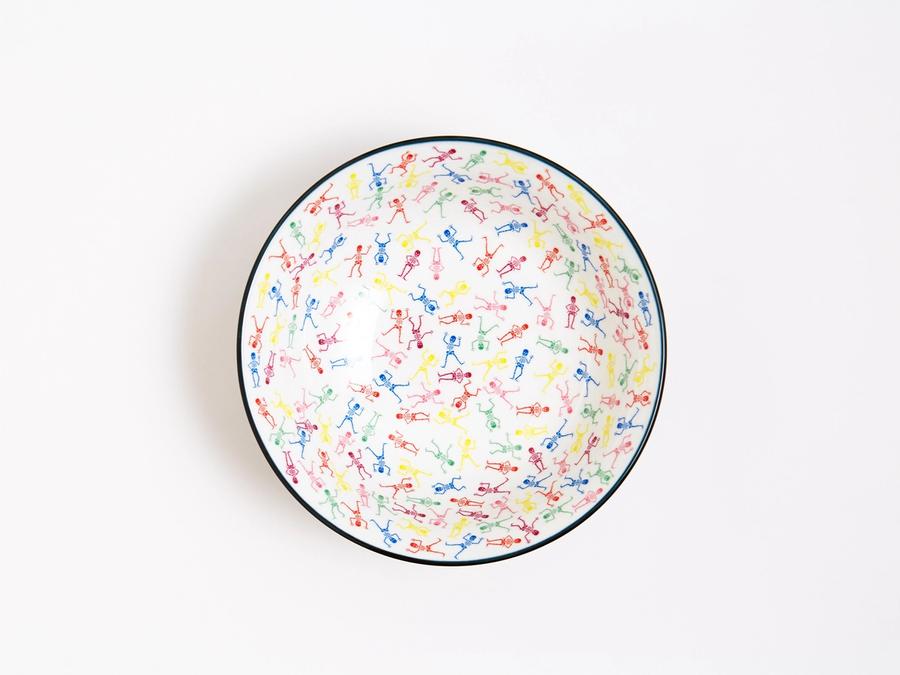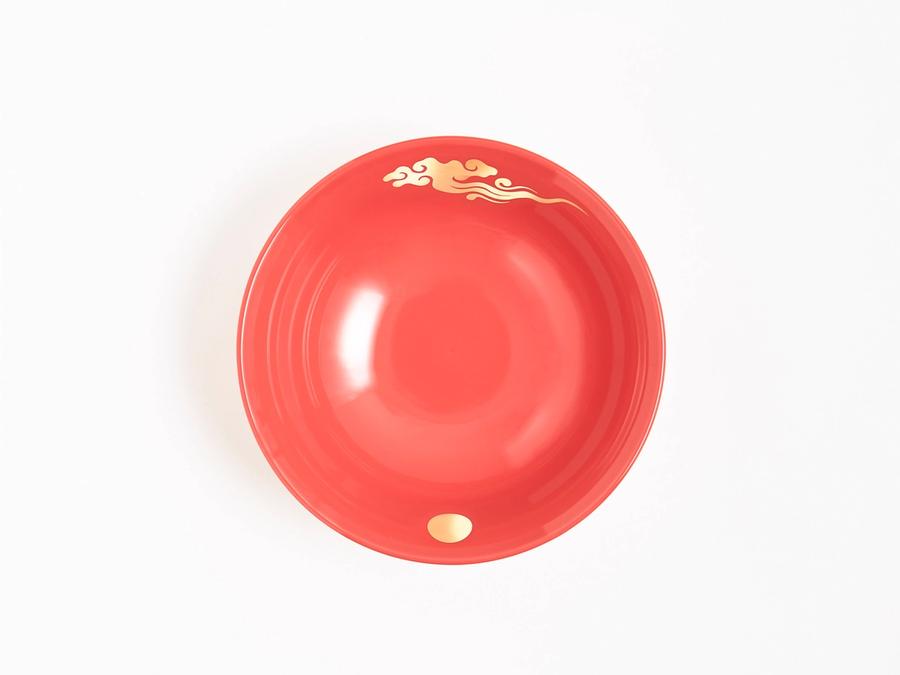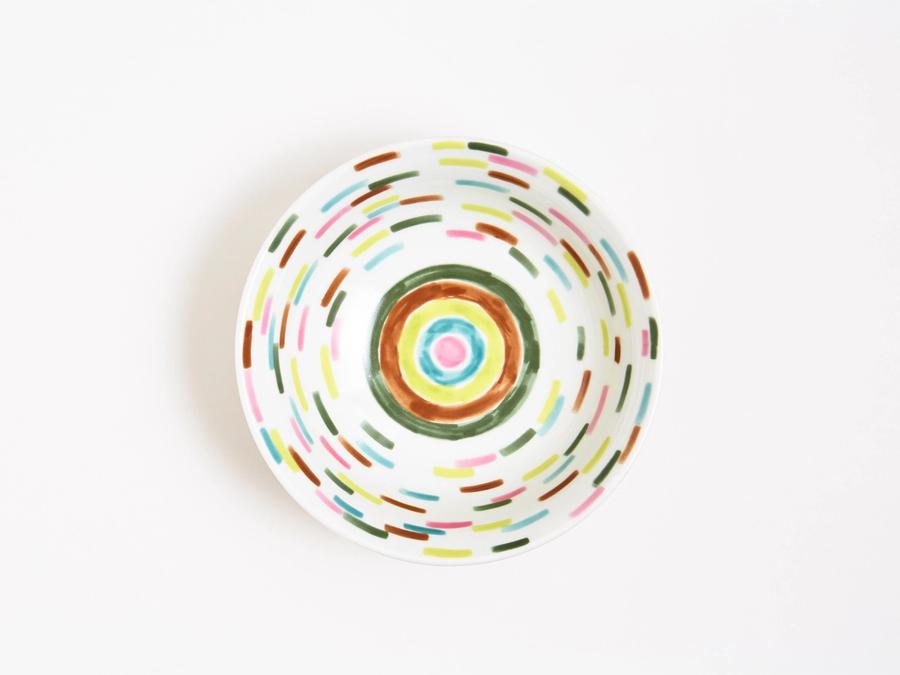Eating ramen is a multisensory experience: the fragrant steam coming off of the broth, the slurping sound of enjoying the noodles, the cozy heat felt upon touching the bowl. The latter object is the subject of an exhibition called “The Art of the Ramen Bowl” (March 18–July 5) that’s on view at the Los Angeles location of Japan House, an initiative with additional hubs in London and São Paulo that was created by the Ministry of Foreign Affairs of Japan to foster awareness and appreciation of the country through a diverse range of programming. Graphic designer Taku Satoh and writer and editor Mari Hashimoto, deputy director of Tokyo’s Eisei Bunko Museum, curated the show, which was first mounted at Gallery Design 1953 inside Tokyo’s Matsuya Ginza department store in 2014. (The presentation at Japan House L.A. is its first in the United States.) The show features 30 donburi, the porcelain receptacles in which ramen is traditionally served, and renge, the compact, teardrop-shaped spoons that often accompany them, made by 30 leading artists, architects, and designers. Here, the dishware is positioned as vessels for not only the beloved dish, but for history, culture, and self-expression as well.
The exhibition’s ode to ramen, a street food brought to Japan from China in the mid-1800s, considers the dish’s many facets. Viewers learn about the origins and composition of the soup, which can take on a number of flavors, styles, and ingredients, as well as the variety of bowls and utensils created across time to accompany it—such as the tableware made in Mino, a city in Japan’s Gifu Prefecture that has been a ceramics hub for more than 500 years and currently produces nearly 90 percent of the country’s donburi. (All pieces in the show were fabricated there, including more than a dozen bowls made specifically for the L.A. presentation.)
Takes on the bowl span the traditional to the experimental: Satoh, the show’s co-curator, adorned one with dragons and a border of multicolored square spirals, while an iteration by artist Hisashi Tenmyouya is embellished with his signature markings, which he calls Neo-Nihonga, that put a contemporary twist on traditional Japanese-style painting. Drawings by Tabaimo, an artist whose work often explores themes of isolation and uncertainty, blanket another bowl that, when filled with ramen and eaten from, gradually reveals male and female body parts (feet, torsos, hands, and arms) and alludes to the progressing phases of a relationship.
Other pieces border on the surreal. Pop artist Keiichi Tanaami covered a vessel in an image of a skull-headed spider—a reference to his memory of watching one drown in his ramen, deterring him from the food thereafter. Most striking is a giant soup-filled ramen bowl by Iwasaki Mokei, a celebrated Japanese manufacturer of ornate food replicas that was founded in 1932. The elaborate resin, PVC, and reinforced-plastic sculpture, which depicts Tokyo-style shoyu ramen, magically captures the allure of the real thing.
A robust roster of public programming offers further context around ramen, along with opportunities to partake of the soup itself. Events include Delicious Design (March 22), a discussion among the exhibition’s curators about organizing the show and the relationship between dishware and design, and The Ceramics of Mino (April 5), a lecture by Morgan Pitelka, a professor of history and Asian studies at the University of North Carolina at Chapel Hill, on the evolution of the region’s pottery. From May through July, a ramen pop-up series, featuring to-be-announced participants, will take place in the building’s restaurant space. However you decide to explore the dish—with your mind, body, or both—the exhibition offers plenty of ways to refuel.
Keep reading
Home is unequivocally where the heart is. But in a world that far too often embraces soulless or downright bland furnituSight Unseen, comes in.
In February 2009, some 500 miles above the Siberian tundra, a defunct Russian satellite and a U.S. communication satelli
While the Danish design firm HAY is just celebrating its 20th anniversary this year, it has achieved a rarefied place in
It’s a serene, bluebird-sky day, a slight chill in the air, and I’m walking with the Paris-based, Austrian-born designerSculpture Gallery, a transfixing space of light and shadow built in 1970 that’s home to works by artists including Michael Heizer, Robert
Ever Heard of Noh Theater? Our Primer to Three Major Productions Arriving in New York City This Fall
Two winters ago, I picked up a copy of Penguin Classics’ Japanese Nō Dramas, a volume of two dozen translations by Royall Tyler I’d been meaning to read since tearing through Yukio Mishima’s Five Modern Noh Plays a decade previous. I had moved into a New York City gem (an apartment with a fireplace), and with Covid cases skyrocketi
As changes in weather patterns, economic realities, and public perception have triggered a wave of climate consciousness over the past few years, renewable energy sources have enjoyed a newfound level of attention, no longer relegated to thlong-sputtering industry of solar power. Factoids like how an hour and half worth of sunlight hitting the earth could provide the world’s total energy consumption in a year have been employed to tease out the industry’s transformative power for decades. Now, with technological advances makincheaper and more efficient than ever, it seems better poised than ever to take on a greater role in weaning humanity off of its fossil fuel and coal depende
Since 1997, when she founded her eponymous (now shuttered) gallery, Elizabeth Dee has been a fixture of the New York artIndependent Art Fair. An elegant, tightly curated event that remains an outlier in its efforts to elevate overlooked, underrepresented, and
What does it mean to revisit a photograph? When a camera shutters, it locks a moment in time, forever trapping the imageGathered Leaves, the latest book by the Minneapolis-based photographer Alec Soth, whose work has long documented lonely souls and fractured dreams in spaces across the United States. In Gathered Leaves, Soth revisits five of his previous books, including in its pages new notes, annotations, text excerpts, and even photo
In 2016, a stampede of people flooded the streets of Taipei, stopping garbage trucks and buses in the wake of their single-minded pursuit. What unifi
Kate Berry’s glowing personality transmits what she seems to desire most: a breath of fresh air, and time to care for her myriad plants; raise her 9-year-old daughter, Quinn; or host intimate dinner parties for friends on the garden-covered terrace of her Domino and of the food, wine, and travel magazine Saveur, Berry has interactions with media that, due to her demanding schedule, tend to be brief and light—and meaningful. She lives her work, which leaves plenty of time for creating media, but not so much for taking it in. As she puts it, “You don’t
Consider the flower. What image blossoms to mind? What emotion does it elicit? For centuries, flowers have persisted as Flora Photographica: The Flower in Contemporary Photography (Thames & Hudson), out August 30, editors William Ewing and Danaé Panchaud compose a selection of vibrant modern floral
Lush fruit trees bursting over a roof. A canopy of plants covering a facade. Intricate bamboo constructions spiraling frVõ Trọng Nghĩa: Building Nature (Thames & Hudson), readers get an inside look into how the celebrated architect has embraced two core themes throughout
As the director of archives and brand heritage at the Michigan-based furniture powerhouse Herman Miller—now known as MilIni Archibong.
The climate writer and essayist David Wallace-Wells has a knack for translating the unimaginable into the painfully realarticle for New York magazine and subsequent book of the same name, The Uninhabitable Earth, played a critical role in jolting the conversation, detailing the varied plagues and, finally, apocalyptic conditions The New York Times, who added him to their Opinion section, where he has begun a weekly newsletter to reflect on the latest in our Anthropocene Age.
“A forest in Norway is growing.” So begins the cryptic text printed on a certificate for the Future Library, or Framtidsbiblioteket, an artwork by Scottish artist Katie Paterson that, over the span of a century, cumulatively builds a collection of wri
At New York’s Lisson Gallery, an unfettered approach to sculpture is the driving force behind a new group exhibition. OnThe Odds Are Good, The Goods Are Odd” presents the work of 11 groundbreaking New York City–based contemporary artists. In the exhibition, sculptures are a m
Earlier this year, Burkina Faso–born Diébédo Francis Kéré became the first African, and the first Black architect, ever
“We think we invent things and create things and define ourselves by ourselves, but that’s not the whole story,” BaratunAmerica Outdoors, a six-part travel series that premiered last week on PBS. Thurston—a writer, comedian, and podcaster who has advised tThe Daily Show, and authored the best-selling memoir How To Be Black—has a knack for navigating nuanced conversations around race, culture, politics, and technology, framing these discussi
Rising from a patch of spiny ornamental grass on New York’s High Line park, a 9-foot-tall tornado spins in place, whirliWindy”, a new (and first-ever) sculpture by the Moroccan-born, New York–based artist Meriem Bennani, installed near West 23rd2 Lizards” (2020), made with filmmaker Orian Barki and launched on Instagram at the start of the pandemic, depicted the bewilderi
The jagged spine of the Rocky Mountains is too beautiful to mar. Yet over the years, developers and builders have manageBuckminster Fuller, Ludwig Mies van der Rohe, Eliot Noyes, and Eero Saarinen completed commissions in the Western United States, transforming it into a hub for architectural modRocky Mountain Modern: Contemporary Alpine Homes (Monacelli Press).
A recurring theme in design critic Alexandra Lange’s work is unpacking how—and for whom—objects and spaces are designed.The Dot-Com City, and surveyed how kids’ toys and physical environments impact their development in her 2018 book, The Design of Childhood. The ways in which outdoor public spaces, with their basketball courts, playgrounds, and skate parks, fail teen girls wa story she wrote for Bloomberg CityLab—one of many publications she has contributed to over the past two-plus decades.
Time standards are one of the many seemingly invisible societal constructs we interact with every day but seldom ponder.Mountain / Time,” the show is a nod to both the local time zone in Aspen, Mountain Standard Time (MST)—which the writer and critic Kylehas hailed for its “apartness” and “sense of detachment from the economic and cultural centers of the nation”—and the conceptual d
Detroit is a city of craft. Of carmakers and Carhartt. Of Motown Records and Eminem. Of iconic midcentury design (Isamu Noguchi’s Hart Plaza and Dodge Fountain, buildings by Mies van der Rohe and Minoru Heidelberg Project. So it’s fitting that, following previous iterations in Copenhagen, last fall, and in Turin, Italy, last month, the Freits latest “Hermès in the Making” exhibition (through June 15). A playful, Willy Wonka factory–like presentation of the company’s know-how, the display offers “an o not to smile while walking through it. Divided into four sections—”A Culture of Traditional Craftsmanship,” “High-Quality Msecret!” Beyond, stations feature artisans in saddle-stitching, porcelain painting, gemstone setting, glove-making, leather wor
Emerging from the pandemic, the design industry, like most of us, has changed. The past two and a half years, which havean increasingly pressing climate crisis, have formed a solemn backdrop. In March 2020, almost at once, in the locked-down lives of many, the notion of “home” a
The concept of the Golden Age was first introduced by the ancient Greek philosopher Hesiod, around 700 B.C., in a refereDesign Miami Basel (June 14–19), taking place at the Swiss city’s Messeplatz. Organized around the theme “The Golden Age: Rooted in the Pa
In her new book, Generation Dread, author and researcher Britt Wray delves into the psychological consequences of the climate crisis. Combining scientifi
May’s colors, textures, and sense of renewal seem to be essential ingredients in Paris-based artist Alexandre Benjamin Navet’s exuberant work. A self-described “spring and summer boy,” his expressive drawings—often made in watercolor or oil pas
How do the generation of Black Americans who grew up in the past 25 years reckon with the tragedies that play out in theThe Trayvon Generation (Grand Central Publishing), poet, educator, and scholar Elizabeth Alexander—who currently serves as the president of the Andrew W. Mellon Foundation, the largest humanities philanthropy in the UnEp. 52 of our Time Sensitive podcast)—explores these questions, and others, by meditating on race, class, trauma, justice, and memory, and their influences
In 1938, two years after completing one of his first realized public artworks, “History Mexico,” a sculptural, colored chis namesake museum in Long Island City, Queens, which he founded in 1985).
In the early 1860s, an advertisement in The New York Times offered $10,000 to anyone who could invent a new material for billiard balls. At the time, elephant ivory was the matercamphor, a waxy substance found in the wood of the camphor laurel tree. Though celluloid would later prove to be less than idea
Think about the last time you felt a sense of awe about the world. Perhaps you were hiking among trees in a lush forest,
Non-fungible tokens, or NFTs (one-of-a-kind digital assets created using blockchain technology), have divided the art woEp. 59 of our Time Sensitive podcast), see them as pathways to a promising future, while others express concern around the sky-high price points and carbon emissions they generate.
A sobering 2006 report by the United Nations Food and Agriculture Organization laid out the striking impacts industrial animal agriculture has
At 35, Maggie Doyne is the mother of more than 50 children. One is her biological child, who lives with Doyne, her husbaBetween the Mountain and the Sky: A Mother’s Story of Hope and Love (Harper Horizon), out last month. Through telling her extraordinary story, she demonstrates the life-altering power of
For most of the 20th century, breaking a sweat was seen as unladylike. Popular opinion considered working out dangerous
One afternoon in February of 1966, Stewart Brand took half a tab of LSD, sat on a rooftop in San Francisco’s North Beach
Anicka Yi’s intoxicatingly sensory installations don’t just surround the viewer—many of them literally permeate the body, their sEp. 14 of our At a Distance podcast), in which three industrial steel tanks saturate the air with an aroma concocted by fusing secretions from carpenter an
Integrative nutritionist Daphne Javitch helps people develop their versions of a healthy life—a potentially daunting tasDoing Well, Javitch, a former womenswear consultant at Theory and Uniqlo, offers private health and career coaching as well as groEp. 46 of our At a Distance podcast.)
Born in Grandin, North Dakota, in 1904, the artist Clyfford Still was among the first generation of Abstract Expressioni
In a single word, how does the future make you feel? A towering sculpture by architect Suchi Reddy, founder of the New Y
Darrin Alfred, the curator of architecture and design at the Denver Art Museum (DAM), has wrangled subjects as mesmerizi
Thick, wobbly lines branch out across a wall of Pace Gallery’s global headquarters in New York. Follow each stroke to itwomen, grandpas, and singers craning toward the ceiling, and donuts, hairs, and holes reaching into the ground. Part absurdist diagram, part heart-melting poem, and part consciousness-shifting artwork, thiDavid Byrne: How I Learned About Non-Rational Logic” (on view Feb. 2–March 19), a restorative survey of drawings the musician has made over the past two decades.
With their audacious, gravity-defying forms, skyscrapers have captured the public’s imagination for more than a century.Skyscraper Page, a zany website with a skyscraper discussion forum that has spread to some 100,000 threads. But what’s the point of obs
In the early ’90s, artist, aesthetics expert, and writer Leonard Koren was bathing at a hot-springs resort near the Japa
“Magazines may be a dying breed,” says Jon Kelly, a former Vanity Fair editor who founded its politics, business, and technology website, Hive, in 2015, after working as a staff editor for The New York Times Magazine and as a founding team member at Bloomberg Businessweek. (His career in media began at Vanity Fair, as an assistant to the legendary editor Graydon Carter.) “But magazine-style writing is always in vogue.” With this coPuck, a subscription-based website where elite writers tell insider stories that lie at the nexus of Hollywood, Wall Street,
At this and at every moment, the Earth, and all the species who reside on it, are pushing through time and space, surrou
The exhibition “AORA V: nature/nurture” (on view through Feb. 27, 2022) takes place within four tranquil galleries that, thanks to ample room-length skylights
Brooklyn design studio CW&T is on a mission to change our perspectives on time. To do so, it adapts everyday objects—including clocks, pens, patche
To Felix Burrichter, the German-born, New York–based founder of the biannual architecture and design magazine Pin-Up, life is a glorious cacophony of different voices, visions, and ideas—and he can’t get enough of them. “I’m never happy
Marked by a snow-white dial with a texture evocative of tree bark, the SLGH005 timepiece from the Japanese watchmaker Grand Seiko was informed by the shirakaba (white birch trees) that thrive in Japan’s northern region, particularly those near the company’s studio in Shizukuishi
New York–based Nigerian artist Toyin Ojih Odutola often uses her creations—eclectic multimedia drawings and works on papA Countervailing Theory” currently on view at the Hirshhorn Museum and Sculpture Garden in Washington, D.C. through April 3, 2022, are possiblyIntersections,” a new body of work by artist Sanford Biggers, who was the guest on Ep. 66 of our At a Distance podcast, on view through Jan. 9, 2022.) Commissioned by the Barbican Art Gallery in London, where it was presented from August
Gabrielle (Coco) Chanel spent her childhood at an orphanage in Aubazines, a commune in central France that was surroundeFive Echoes” (on view Nov. 30 through Dec. 21)—located in the Miami Design District’s outdoor event space, Jungle Plaza—is a sprawlEp. 28 of our Time Sensitive podcast.)
To the attentive ear, symphonies abound—especially in the wild. Musician and author Bernie Krause has been recording natEp. 127 of our At a Distance podcast, has captured more than 5,000 hours of audio created by more than 15,000 terrestrial and marine species in some 2,000 h
When experiencing a crisis, some people see opportunities—for reflection, change, or innovation—that they might not recoAt a Distance podcast was created during (and as a result of) perhaps the widest-reaching calamity in human history—the Covid-19 pandAt a Distance: 100 Visionaries at Home in a Pandemic (Apartamento), out today, presents a selection of these conversations in physical form. The book’s introduction, writte
“The Hare with Amber Eyes” (on view Nov. 19, 2021, through May 15, 2022) is a remarkable, meditative exhibition at New York’s Jewish Museum basedNew York Times bestselling family memoir of the same name by London-based artist, author, and master potter Edmund de Waal (who was thEp. 99 of our At a Distance podcast). The show traces the history and migration of the artist’s relatives, who descended from Charles Ephrussi—a Paris-base
Gucci. The luxury fashion house’s name alone conjures up images of vibrancy, extravagance, experimentation, and offbeat latest episode of Hello Fashion, Young’s YouTube show created with The Slowdown, she investigates how this “world” came to be by illuminating the house
Brooklin, Maine–based science writer and children’s book author Kimberly Ridley began her latest project by setting up aWild Design: Nature’s Architects (Princeton Architectural Press), out next week.
In the sphere of luxury fashion, Dior’s richness of history is practically unparalleled. As stylist Kate Young says, Diolatest episode of Hello Fashion, Young’s YouTube show created with The Slowdown, was filmed. In the episode, Young takes us through Dior’s aesthetic tr
In 1847, French jeweler Louis-François Cartier established a business that bore his last name and specialized in jewels
What does a trench coat represent? For stylist Kate Young, it’s a marker of sophistication, exploration, and evergreen slatest episode of Hello Fashion, her YouTube show created with The Slowdown, Young introduces us to the piece’s original architect—the British luxury f
The nonprofit collective MASS Design Group astutely understands how to promote equity and hope through the built environThe Architecture of Health (Cooper Hewitt, Smithsonian Design Museum), as well as the upcoming Cooper Hewitt National Design Museum exhibition “Design and Healing” (December 10–August 14, 2022)—MASS understands how architecture can impede or advance our collective human rights. (ThEp. 13 of our At a Distance podcast.)
Five years ago, under the cloak of darkness, New York–based floral designer Lewis Miller packed his team and 2,000 dahlias and carnations into a van, and headed for the John Lennon Memorial in Central Park. W
Can clothing be at once opulent and utilitarian, traditional and unexpected, ugly and sublime? Can it be both a statemenlatest episode of Hello Fashion, her YouTube show created with The Slowdown, stylist Kate Young explains the ways in which the Italian luxury fashion h
According to business coach Holly Howard, those looking to run a flourishing enterprise should begin by taking a deeper Ask Holly How, in 2012. Since then, she’s worked with more than 500 businesses and founders, guided by the belief that effective entr
Tantric Buddhist practitioners use mandalas—circular, often ornate, symbolic representations of the universe that can apMandala Lab, an interactive multi-sensorial space that opens October 1 at New York’s Rubin Museum of Art, an institution dedicated
Luxury and utility don’t often go hand in hand. French fashion house Louis Vuitton, however, is a clear exception: As stHello Fashion, her YouTube show created with The Slowdown, the house—though now one of the world’s most recognizable fashion brands—wthe episode, Young walks us through the evolution of the house and its designs, which have consistently checked the boxes for both
Since 1915, New York Public Library users in search of visual information have consulted its Picture Collection. It consists of images cut from magazines, catalogues, and books, each glued to backings and organized into folders enc
As a stylist, Kate Young has a particular affinity for well-designed things—that is, iconic items that stand the test ofknow what Cartier is. It’s sexy. It’s French. It’s sort of, always, for me, rooted in the seventies.” To kick off Season 2 oHello Fashion, her YouTube show created in collaboration with The Slowdown, the stylist walks through some of the famed French jewelr
In branding and marketing, animal imagery abounds: Lacoste’s crocodile, Bacardi’s bat, Geico’s gecko, Swarovski’s swan, according to the United Nations Development Programme (UNDP), animals appear in approximately 20 percent of all advertisements. These creatures, however, receive little to n
In Chicago, more than 10,000 city-owned lots currently sit vacant, concentrated within predominantly Black and brown comChicago Architecture Biennial in 2015. Now, as the latter biennial’s 2021 artistic director, Brown further expands upon his project, using it to info
The title of Yves Béhar’s new monograph, Designing Ideas (Thames & Hudson), gets straight to the heart of the Swiss designer and entrepreneur’s 20-year career. After founding h
Floral jewelry has been a tradition of the French jewelry house Van Cleef & Arpels since it opened its first boutique atFlorae” (on view through November 14), presented alongside floret-filled photographs by Japanese photographer and film directo
In 1983, French photographer Simon Chaput arrived in New York City for a weeklong trip, and ended up staying for nearly –1991) in California and Japan to “The Floating Piers” (2014–2016) in Italy. Along the way, in 1984, Chaput met the artist and sculptor Isamu Noguchi, who recognized Chaput’s love oNew York,” which he began in 1996, that chronicled the developing built environment of Lower Manhattan.
“In the last few years, something distinctly different has been happening in the ways that technologies come to market, The Economist, and launched a popular tech newsletter and podcast called Exponential View. (Last year, he discussed the present-day role of the smartphone, among other digital-related issues, as the guest on Ep. 56 of our At a Distance podcast.) Azhar cautions against the speed with which innovations such as artificial intelligence, automation, and big data emeThe Exponential Age: How Accelerating Technology Is Transforming Business, Politics and Society (Diversion Books), out next week. With clarity and insight, he outlines new ways of thinking about technology, alongsid
Wassan Al-Khudhairi, the chief curator at the Contemporary Art Museum St. Louis, is the curator of this year’s Focus, a Armory Show—one of America’s biggest art fairs, on view from September 9–12 at New York’s Javits Center—that features contemporary
The concept for Geoff Manaugh and Nicola Twilley’s new book, Until Proven Safe: The History and Future of Quarantine (MCD), began forming about 12 years ago, when the world looked considerably different from the way it does now. During aEp. 33 of our At a Distance podcast) noticed an old quarantine station turned luxury hotel on a picturesque peninsula across the bay. “Our first questions
When architect Mies van der Rohe first used the now infamous—and often riffed-on—phrase “Less is more,” it was in refere
In 2018, contemporary art dealer David Zwirner hired the young Elena Soboleva to optimize his galleries’ online sales operation and digital presence—prompting some critics to respond with skepticis
Jonathan Chapman, a professor and director of doctoral studies at Carnegie Mellon University’s School of Design, is intrMeaningful Stuff: Design That Lasts (M.I.T. Press), out next month, Chapman shows how unhealthy patterns of consumption can be disrupted by creating fewer, Why, psychologically, are we excited by new designs? And how can we establish better connections with the things we al
The underlying vision for “A Diagnosis of Time: Unlearn What You Have Learned,” a collaborative exhibition between the ASavannah Centre for Contemporary Art (SSCA) in Tamale, Ghana; and the Ghana Museums and Monuments Board (on view through November 3), is both literally and This is Not Africa: Unlearn What You Have Learned,” currently on view at ARoS through October 24, challenges stereotypical Western notions of African-ness.)
Omer Arbel, an Israeli-born, Vancouver-based artist and designer who creates boundary-defying objects and architecture, Omer Arbel (Phaidon), edited by Stephanie Rebick, an associate curator at the Vancouver Art Gallery, celebrates the depth and bread
As Paris emerges from lockdown and its streets come alive, the Fondation Cartier pour l’Art Contemporain, an art center Cherry Blossoms” (on view through January 2, 2022), an exhibition of expressively impastoed, large-scale oil paintings by British artistold the BBC. “My mum used to say, ‘There’s enough horror in the world. Why can’t you just paint flowers?’ So maybe she got to me.”
Los Angeles–based journalist Doree Shafrir sees beauty in the particular challenges faced by those who find their footin, pours her lighthearted yet critical perspective on her experience into Forever35, a self-care podcast she co-hosts with her longtime friend Kate Spencer, and into her new memoir, Thanks for Waiting: The Joy (& Weirdness) of Being a Late Bloomer (Ballantine Books), out this week. In the book, she interrogates the often overwhelming pressure that people—particular How do you start your mornings?
“Social Works,” a group exhibition that opened this week at New York’s Gagosian gallery on West 24th Street, explores space—and the m
“Clouds are not something to moan about,” Gavin Pretor-Pinney says in a 2013 TED talk. “Far from it. They are, in fact, the most diverse, evocative, poetic aspect of nature.” Pretor-Pinney, a British authoThe Idler, a magazine that extols the virtues of slowness, became fascinated with clouds after noticing them in the skies depicte
To showcase the world’s most inventive designers, the London Design Biennale invites participants who represent their coEp. 75 of our At a Distance podcast, recorded last September. “I thought, Well, who do I identify with?”
Several years ago, Claus Sendlinger began contemplating ways to address his concerns about overdevelopment in the boutiqSlow, a hospitality venture dedicated to creating places that draw upon their locations’ culture, environment, and history aagriturismo (farmhouse retreat) called La Granja. The working farm practices regenerative agriculture, and teaches visitors how it
In this age of instant gratification, fast fashion innocently presents itself as a way to meet consumer demand. But behiUnraveled: The Life and Death of a Garment (Portfolio), out next week. In the book, Bédat, a former lawyer (and the guest on Ep. 11 of our At a Distance podcast), traces the lifespan of a pair of jeans to demonstrate the ills that accompany the processes that produce our clothes. What exactly is the driving force behind fast fashion?
The first Monday in May is synonymous with the Met Gala, a benefit for the Metropolitan Museum of Art’s Costume InstitutVogue. “Designers live for it.” This year, the affair hasn’t happened yet—it may happen this fall—but to mark the annual occathe eighth episode of Hello Fashion, created with The Slowdown.
To stay healthy, we know that our bodies need nourishment, hygiene, and exercise. According to those who study neuroaestEp. 34 of our At a Distance podcast) who runs the International Arts + Mind Lab (IAM Lab)—an initiative at John Hopkins University’s School of Medicine that connects brain scientists with artists to Arts + Health & Wellbeing, an immersive online tool kit that offers visitors an engaging dose of art, and consequent mental fitness, from anywherEp. 11 of our Time Sensitive podcast.)
“A question I get asked a lot is, ‘How do I get your job?’” says stylist Kate Young. “That answer is complex, because pe10th episode of Hello Fashion, created with The Slowdown.
Practically everything the artist, master potter, and writer Edmund de Waal touches turns to dust. Or at least toward the idea of dust. In each of his books—2010’s The Hare With Amber Eyes, 2015’s The White Road: Journey Into an Obsession, and the just-published Letters to Camondo (Farrar, Straus, and Giroux), out this week—dust serves as a profound metaphor. Throughout his work, whether in pottery or prose, de Waal explores various notions a
From a fashion perspective, the Golden Globes stands apart from other award shows for its timing: The event, during whicleft at that point,” says stylist Kate Young in the ninth episode of Hello Fashion (created with The Slowdown), noting that she usually starts working on Globes outfits around Halloween. For the episode
Julian Sancton knows a thing or two about bone-chilling temperatures. “For a while, I’ve been visiting a friend’s uncle’Departures magazine for nearly a decade. Despite the getaway’s frigid conditions, he continues, “It’s just so beautiful, and gave Belgica spent a sunless winter frozen in the Antarctic ice. Sancton traces the historic voyage, which wasn’t exactly smooth saiMadhouse at the End of the Earth: The Belgica’s Journey Into the Dark Antarctic Night (Penguin Random House), out this week. We recently spoke with Sancton about what he read during his research, and the ne Tell us about some of your favorite books on polar expeditions.
Arts education opportunities faded fast for kids in the learn-from-home fog of Covid-19. That’s where The Look Make Show, a new TV program by New York City’s Children’s Museum of the Arts, hopes to come in. The cartoon, of which the creatorKickstarter campaign through May 14, focuses on Rod and Coney, two rotund, charismatic artists who refuse to let the pandemic get in the way
Seasoned stylist Kate Young never arrives at any event unprepared. Whether it’s the red carpet, a shoot, or a press funcOn the seventh episode of Hello Fashion, created with The Slowdown, Young shares some of the essentials she places inside every travel bag, along with insider
Debates about whether encyclopedic museums—institutions that collect and contextualize cultural artifacts across time an—should act as more than mere repositories date back decades, but have taken on a new urgency as of late. Now, institutioEp. 12 of our At a Distance podcast), tackled these topics through interviews with nearly 30 leaders, and compiled the conversations in a new book, Under Discussion: The Encyclopedic Museum (Getty Publications). We recently spoke with Grau about the future of institutions and the layered, ever-evolving narra What central issues do encyclopedic museums face today, and what prompted you to explore them?
When attending runway shows, stylist Kate Young keeps her eyes peeled for premiere dresses—gowns to be worn by actressesOn the sixth episode of her YouTube show, Hello Fashion, created with The Slowdown, Young talks about her process for selecting and securing premiere dresses, and highlights f
New York–based stylist Kate Young devotes her YouTube show, Hello Fashion, created with The Slowdown, to explaining the ins and outs of celebrity styling. Her wide-ranging explorations about whOn the series’ fifth episode, Young answers various audience questions, submitted in the comments section of her YouTube channel and on her Instagram.
The Covid-19 pandemic, by its very nature, has led to a universal turning toward—or even retreating to—home. The very noTadao Ando: Living With Light (Rizzoli), out this week, that presents 11 extraordinary residential projects designed by the Japanese architect, who has created more than 100 ho


